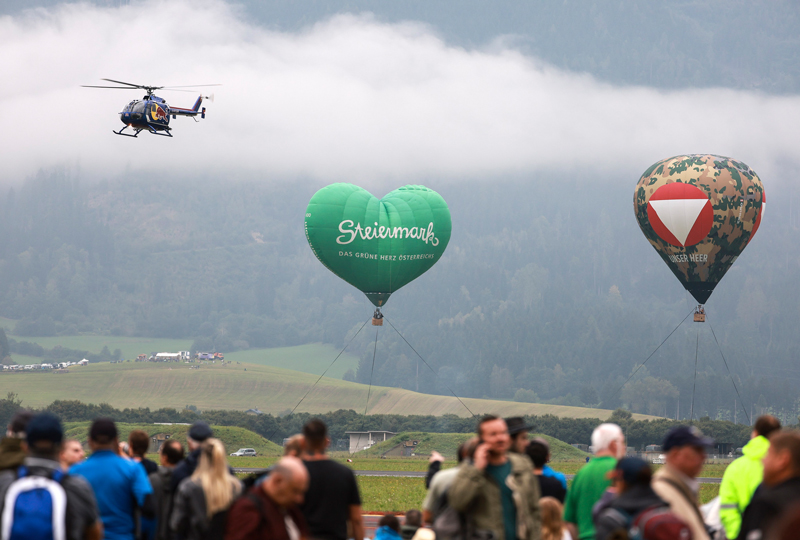
Eskil Amdal has been fascinated by flying since childhood, and even as a teenager he knew he would become a pilot. (https://www.instagram.com/eskilamdal/) Today, the former Norwegian Air Force pilot is part of the Flying Bulls crew and the only pilot in the world to have flown both the P-38 and F35. In this interview, Eskil Amdal talks about his dream of becoming a pilot, the special challenges of being a “flying bull” and what he expects from AIRPOWER22.
Hi Eskil, you are a native of Norway and were part of the Norwegian Air Force. How did your path cross with that of the Flying Bulls?
I met the Flying Bulls in 2012 in Norway. They did a Scandinavian tour and I flew solo displays with the F-16 at that time. We are all avid flyers and have a soft spot for historic aircraft, so it wasn’t difficult to strike up and stay in conversation. I was an ‘experimental test pilot’ for the Norwegian Air Force at the time and flew the F-35 in Alaska, among other places. In 2018 we met again for a DC-6 simulator training, since then I was a ‘part-time’ crew member of the Flying Bulls, since last year I am a real Flying Bull.
What are the special challenges as a Flying Bulls pilot?
It is the variety of different aircraft from different eras of aviation history. You have to know each airplane as well as each helicopter very well before you can take off with them. Most pilots fly one or two aircraft; in the Flying Bulls, pilots typically fly between 10 to 15 different types.
How many different types of airplanes and helicopters do you have in your logbook?
I think I flew a total of 126 aircraft, 8 of which were helicopters. And a few gliders.
Is there also a favorite aircraft in this impressive selection of aircraft already flown?
It’s really hard to say … I think the F-16, the F-35, the Starfighter, the Spitfire and the P-38 are among my all-time favorites.
It’s fitting that the P-38 is also part of the Flying Bulls fleet. What are generally your favorite aircraft from Hangar-7 and Hangar-8 in Salzburg from the Flying Bulls fleet?
I grew up with fighter planes, so of course the Corsair and the P-38 are very special types of aircraft to me. Also, the DC-6 is just fantastic.
When did you first become fascinated by flying?
Since childhood. At the age of 12 I flew for the first time with a radio controlled airplane and the fascination never left me. It seems like yesterday …
When did you decide that you wanted to become a professional pilot?
My cousin landed a military helicopter on our farm, I was 15 at the time, and it captivated me so much that I decided for myself that I absolutely wanted to become a military pilot. I knew it would be difficult to make it, but I just had to try. Of course, the fact that it worked out was a dream come true for me. I began my flight training with the Norwegian Air Force in 1994 and received my “wings” at Sheppard Air Force Base in 1996.
What were your main duties as a Norwegian Air Force pilot?
As a so-called aerial reconnaissance officer, I was the leader of a small team that was deployed in the field for about half of the year in all kinds of weather. It was a great challenge, especially to keep my colleagues safe and warm in the dark during the harsh winters north of the Arctic Circle.
In 2007 you became ‘Experimental Test Pilot’. That sounds very exciting, of course, but also risky. Or is it not?
Of course, there are missions that are more dangerous than others. But overall, missions are well rehearsed in the simulator, etc., before testing new aircraft. With old aircraft it is often different, there are usually no simulators and no redundancy in the systems. This is a very special challenge and a lot of work to prepare for.
Eskil, you were the first Norwegian pilot in an F-104 Starfighter since 1983? Was that a special moment for you?
Yes, definitely. As a child, I always built models of the Starfighter. I never imagined that this dream would come true. It is a very special machine and I feel very lucky to have had the chance to fly it. You can’t see the wings from the cockpit, and the seat is in front of the nose gear, so you feel like a rocket just taxiing. If you don’t extend the flaps on approach, the speed on final approach is about 270 knots …
And you are the only pilot in the world who has flown the P38 and the F35. What does that mean to you as a flight enthusiast since early childhood?
It is of course a great privilege to fly one of these aircraft, but it is even greater to be able to fly both. Mainly because it gives me the opportunity to witness the development of fighter aircraft over several decades. From simple piston engines and cables to extremely advanced flight computers. However, the philosophy behind it has not changed and both are wonderful to fly.
What do you expect from AIRPOWER22?
AIRPOWER22 is a special airshow for all of us, I can’t wait for it to finally start. We are preparing intensively for this. You can already be excited, because the Flying Bulls will be there again with an exciting selection of airplanes and helicopters in Zeltweg.
FOTOCREDITS
© Helge Kircherger